
It looks a lot like this 18th-century illustration of mountain lovage (Ligusticum mutellina)
from the NYPL digital image library.
Its appearance is celery-like too: flat leaves, with a shape familiar to those who seek out bundles of celery with as much foliage as possible still attached, for adding to salads and soups and anywhere parsley would go. (If you've never taken apart a tidy pile of celery bundles at the grocery store to get at the one with the most lush and perfect leaves, try it some day; they are worth searching for, and it's easy enough to neaten up after yourself after you get your secret goodies that no one else cares about). Lovage stalks, too, look very much like celery, although they're more slender, and too fibrous to chew happily. That shouldn't stop you from adding them to something you're braising or simmering, though, and fishing them out at the end of cooking along with all the other woody bits like bay leaves and thyme stems. Or you could throw them in your bath "to increase attractiveness and attract love."
I've mentioned lovage in the past — remember the focaccia with strong herbs, for people with strong personalities? or the stuffed squash? — but only in passing, and my recent experiences with it convinced me I need to grow it on my fire escape to be assured of having a steady supply of it.

My first use of it was to add a tablespoon or so (finely chopped) to a super-simple salad that would have been completely unremarkable without it: a can of white beans, a handful of sliced cherry tomatoes, a handful of the first local snap peas of the season (trimmed and halved), and a dressing of nothing more than olive oil, lemon juice, salt and pepper. I threw this together one morning and took some of it to work, and voilà, my lunch outside at grey old 1 Chase Manhattan Plaza was a picnic. The lovage added a brightness that demanded to be noticed, but it wasn't overpowering. It gave the salad an intense celery flavor but in the nicest possible way, like celery might taste if you pulled it straight out of a garden still warm from the sun. If you try this make sure you rinse the beans well under plenty of cold water; they can taste like can otherwise.
The most memorable lovage-bedecked meal was a dinner of seared seitan with a wilted lovage sauce.

We ate this with some quinoa studded with braised radishes, steamed radish greens and flowering chives, and the rest of the snap peas, barely-steamed and tossed with a little butter and chopped lemon balm. An unlikely assortment of ingredients, but a very pleasant dinner. There's a lot of lovage in the sauce considering how intense it is compared to other herbs, but the seitan is flavorful and chewy enough to support it. Think of it as sort of an eccentric vegetarian take on steak with maître d'hotel butter. The quinoa will get its own post soon but how to give a recipe the lovage sauce when I didn't measure anything? I'll do my best at reconstructing it but use your judgment (i.e., if the sauce looks dry, add a splash more wine, and if you added too much wine, let it reduce a little longer).
seared seitan with wilted lovage sauce
serves 2 to 3 people
8 ounces seitan (this one is perfect), sliced 1/2" thick and patted dry
2 teaspoons olive oil
2 tablespoons butter, plus a bit more near the end of cooking
1/3 cup white wine or dry vermouth (Noilly Prat is good)
1/2 cup loosely-packed lovage leaves, finely chopped
sea salt and freshly ground pepper
Sear the seitan in the olive oil over medium-high heat in a non-stick pan. When it is evenly browned on both sides, remove it from the pan and set it aside. (Don't cover it tightly, though, or you'll lose the nice crispness around the edges). Wipe out the pan with a paper towel and melt the butter over low heat. Add the wine or vermouth, turn up the heat to medium-high, and let it simmer until it is reduced by half (or by a third, if you are hungry and impatient). Stir in the lovage and cook for another two minutes or so. (It should be thoroughly wilted and softened). Take the pan off the heat, season the sauce with a pinch of salt and some pepper, and add a bit more butter (an additional 1/2 a tablespoon will help the flavors come together; a full tablespoon is better). Stir gently just until the butter is melted. Spoon the sauce over the seitan and serve right away.
Later in the week the lovage did something interesting for prosaic stuffed mushrooms, which I might never have even bothered to make without it.
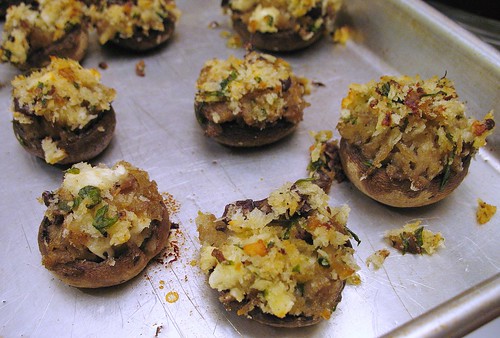
I had large white mushrooms and an annoyingly close-to-finished bag of panko bread crumbs taking up space in the cabinet, so I sautéed a finely minced shallot with some of the mushroom stems (maybe 1/2 of the stems) in 2 tablespoons or so of olive oil until both were softened, turned the heat off, let them cool, then stirred in a tablespoon of finely chopped lovage, two tablespoons or so of cubed sheeps' milk feta cheese, and enough panko bread crumbs to stuff all my mushroom caps. I baked the stuffed mushroom caps for maybe 15 or 20 minutes in a 375°F oven and they were just the right crisp thing to have with a dinner salad in place of bread. Stuffed mushrooms are an old-fashioned cocktail party-type of food and whenever people do make them now they tend to get self-conscious and make them too rich. Preparing them simply this way and not weighing down the stuffing with cream or too much gooey cheese reminded me that they can be fun to eat. If they look dry on top before you put them in the oven, drizzle some olive oil or white wine or dry vermouth over them, or even a tiny splash of water flicked from your fingers. The stuffing should be light and crisp, but not so crisp that diabolical shards of breadcrumbs shred the roof of your mouth.
There's more: we were not out of lovage just yet. I had a craving for cornbread so that's where it went. If you hold fervent beliefs about traditional cornbread ingredients, rest assured that I didn't screw with much else about it. It's still very basic, very spot-on (for me, at least) in terms of flavor and texture; it's just that the lovage added a deep green garden note to it.
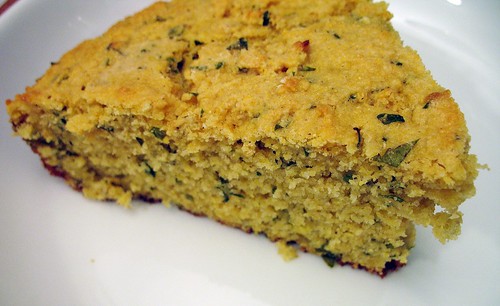
I have been using this Food & Wine recipe for corn bread for years. Although there's no text accompanying the recipe, I believe they may have taken it from the Dean & Deluca Cookbook, since that's what I have it attributed to in my recipe collection. (The recipe section of their website used to be a lot fuller in the early days of the internet, although there's still a lot there).
lovage cornbread
Makes one 9" round cornbread.
Adapted from this recipe, which makes double the quantity. I have always reduced the amount of sugar when I make it because I can't abide sweet cornbread, but of course you may prefer it that way.
A cast iron skillet (see below) is recommended but not absolutely essential. You can follow the same process with any baking pan that's the same size.
1 1/2 tablespoons peanut or vegetable oil
3/4 cup all purpose flour (I used white whole wheat this time and it didn't really behave differently than AP)
1 1/4 cups stone-ground cornmeal
2 scant tablespoons sugar
1 tablespoon baking powder
1 teaspoon fine sea salt
1/4 cup finely chopped lovage leaves
1 cup buttermilk (I used low-fat cultured buttermilk this time but I have used the powdered stuff many times and that's fine too, as is regular milk)
2 large eggs, lightly beaten
3 tablespoons butter, melted
Heat the oven to 425° F.
Stir together the flour, cornmeal, sugar, baking powder, salt and lovage. Add the buttermilk, lightly beaten eggs, and melted butter and stir just until the ingredients are thoroughly combined. (If you are using white whole wheat flour in place of all purpose, as I did, the batter will look a little shaggy; that's perfectly fine).
Swirl the oil around to coat the interior of a 9" cast iron skillet and heat it over medium-high heat until it is hot but not smoking. (Alternatively, if you're using a baking pan, heat it in the oven). Pour the batter into the skillet or pan (it may bubble and hiss, so be careful) and bake for approximately 20 minutes, or until the top is springy when pressed and lightly browned. The bread is at its best while still warm but leftovers reheat well.
Even with one pan of cornbread rather than the two the original recipe produces, we still had quite a bit for two people to eat. Thus the last 1/4 of the bread (and some of the buttermilk I'd bought to make it) ended up in an improbable but very tasty preparation of stuffed zucchini.
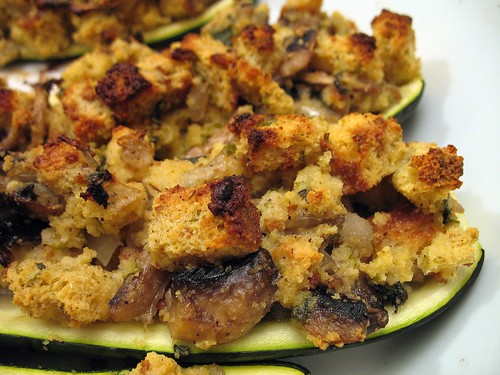
I added some fresh sage since I had some on hand, but thyme would be great too.
improbable stuffed zucchini
2 medium zucchini
4 large mushrooms (120 g/4.25 ounces), sliced
1/2 of a small sweet onion, finely chopped (approximately 1/3 cup)
2 tablespoons butter
1 tablespoon finely sliced fresh sage (or finely chopped thyme)
fine sea salt and freshly ground pepper
1/4 of a 9" round cornbread (a little stale is fine), cut into 1/2" cubes
3/4 cup cultured low-fat buttermilk (or whatever type of buttermilk you have; vegetable stock would probably work too)
a tiny bit of oil for whatever you're going to bake the zucchini in
Halve the zucchini the long way and scrape out the seeds. A grapefruit spoon is perfect for this. I sprinkled the interiors with salt and left them upside-down to drain some of the water out, but I'm not certain it's necessary.
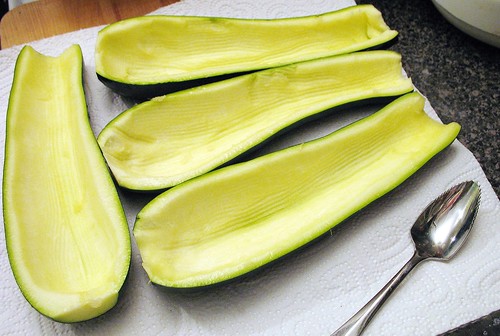
Sautée the mushrooms and onions in 2 tbsp butter until soft. The mushrooms will have given off some liquid and although you would normally cook it off, it's fine to leave a bit in the pan here, since you don't want the stuffing to be too dry.

Heat the oven to 375° F.
Stir the sage or thyme into the mushroom and onion mixture and season it generously with salt and pepper. Gently stir in the cubed cornbread and the buttermilk. Stir just until the bread is thoroughly integrated with the other stuffing ingredients, taking care not to mash it into a mush.
Use the bread mixture to stuff the zucchini and bake them in a lightly oiled pan for approximately 25 minutes, or until well browned.




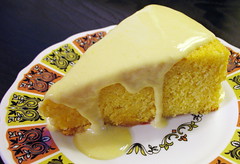
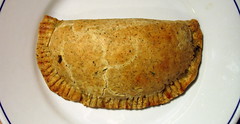


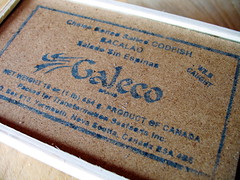

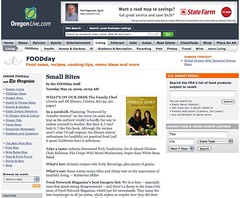





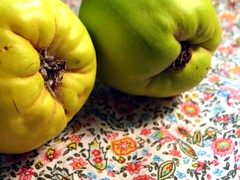
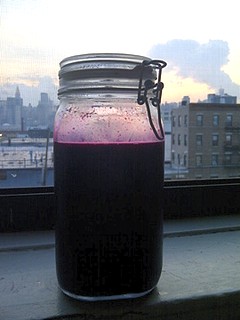
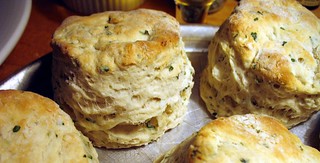

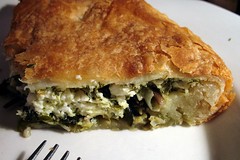


omg, yum! i have never tried lovage before, but i'm going to look for it on my next trip to the union sq farmer's market. sounds incredible and those recipes... yumyum!
ReplyDeleteGood luck finding some! I want to go back and get more to make all the things I didn't get to with this bunch of it. I can't get the idea of lovage pizza out of my mind; I think it would be so nice with super-fresh mozzarella.
ReplyDeleteThis looks delicious! I can't wait to try it!
ReplyDeleteThanks John; let me know how any of the recipes work out for you if you try them. I *am* going to get around to posting the lovage pizza one of these days but there are some pastas I have to get out of the way first while corn and tomatoes are still in season.
ReplyDeleteI *finally* found lovage at the garden store this spring, planted it, and kept my eager-to-harvest hands off of it until a couple of weeks ago so it would grow strong and come back perennially. My first use was in a stuffed squash recipe. I am in love. Using it in etouffee today! Excited to try more of your recipes. Why isn't the world crazy about lovage? It's unique in flavor, and such a pretty plant.
ReplyDeleteHey there mulchaddict, I'm happy to hear you're loving your lovage! I've been harvesting loads of it this summer from my fire escape garden. Try it with summer corn. Slice the kernels off the cobs, cook them in olive oil or vegetable oil until they're getting browned and caramelized, and after you take it off the heat, stir in some chopped lovage, salt & pepper, sliced cherry tomatoes, and maybe some crumbled feta cheese.
Delete